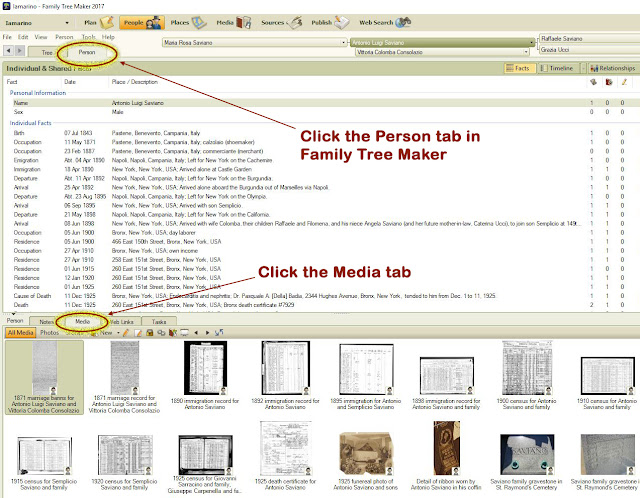When my in-law's father died, she knew nothing about his family but his parents' and his sister's names. I offered to build her family tree. With only a few names and the states where they lived, I was able to add several generations to her tree.
 |
| The exact address where my grandfather was born in Italy. |
It wasn't hard because they'd lived in America for so many generations. Census records offered a way to trace the family's moves from state to state.
But only a few groups of people have lived on the same continent since before recorded history. At some point, everyone else immigrated.
To trace your family back to another country, you must find out exactly where they came from. Once you find that town name, you'll know where to search for birth, marriage and death records.
Here are 4 of the best places to find your ancestor's hometown.
1. Ship Manifests/Immigration Records
The later your ancestor came to your country, the better. Before the 1890s your ancestor's ship manifest may tell you only their home country. A later immigration record can give you that important hometown.
While researching my great grandmother Maria Rosa Caruso, a cousin said Maria Rosa mentioned her Italian hometown often. She called it "Pisqualamazza".
 |
| My great grandmother's hometown, seen on her immigration record. |
Unfortunately, there is no such town. My research was at a standstill. So I searched for anyone named Caruso coming to New York from a town that sounded like "Pisqualamazza".
And I found it. My great grandmother's 1906 ship manifest shows it, and the transcription on Ancestry.com helped me read it. My great grandmother's Pisqualamazza was Pescolamazza!
When I found no such town on a map, I Googled it. Pescolamazza changed its name to Pesco Sannita in 1948, so my great grandmother knew it by its old name.
2. Draft Registration Cards
My great aunt told me our Saviano family was from Avellino, but that's not specific enough. Avellino is both a city and a province with many towns. I was stuck.
It was my 2nd great uncle's World War II draft registration card that changed everything. He was 64 years old in 1942, but he still had to register. Thank goodness. Because, despite 2 spelling errors, I learned he was born in Tufo, Avellino. I looked at an online map to find the correct spelling.
 |
| This 1942 draft registration card gave me the exact location I needed. |
Shortly after that discovery, I found his 1877 Tufo birth record, and that of his older brother none of my cousins had ever heard of.
3. Naturalization Papers
My grandfather came to America in 1920 at the age of 18. He first went to live in Newton, Massachusetts, where his uncle lived. Then he went to work in Western Pennsylvania where he applied to become a U.S. citizen.
His "declaration of intention" papers include his hometown of Colle Sannita, Italy, and his birth date—which is not what we thought it was. Knowing his hometown, I was able to get his 1902 birth record from the Italian archives. This confirmed that he was born on October 8, just like it says on his declaration of intention.
 |
| Naturalization papers can provide birth dates and places—sometimes for an entire family. |
4. Passport Applications
It's always a thrill when you can find your ancestor's passport application, complete with a photo. My cousin Attilio Sarracino's passport application confirmed that he was born in New York. But his father, Carmine, lived in Pastene, Italy.
 |
| There may be typos, but a passport application provides solid information you need. |
Members of this family went back and forth between Italy and America a couple of times. I found a record of Attilio's 1907 U.S. birth in Pastene, Italy's 1909 register book. They needed him on the record books because his family was planning to stay in Italy and raise him.
Finding these documents helped me make sense of family lore. "Pisqualamazza" wasn't a place. "Avellino" was too vague. And there are 2 towns (Pastene and Pastena) with families named Sarracino!
Before you dive into a new collection of foreign vital records, find all the domestic records. Make sure you know your ancestor's hometown so you don't end up chasing documents that aren't there.
And speaking of finding important records:






